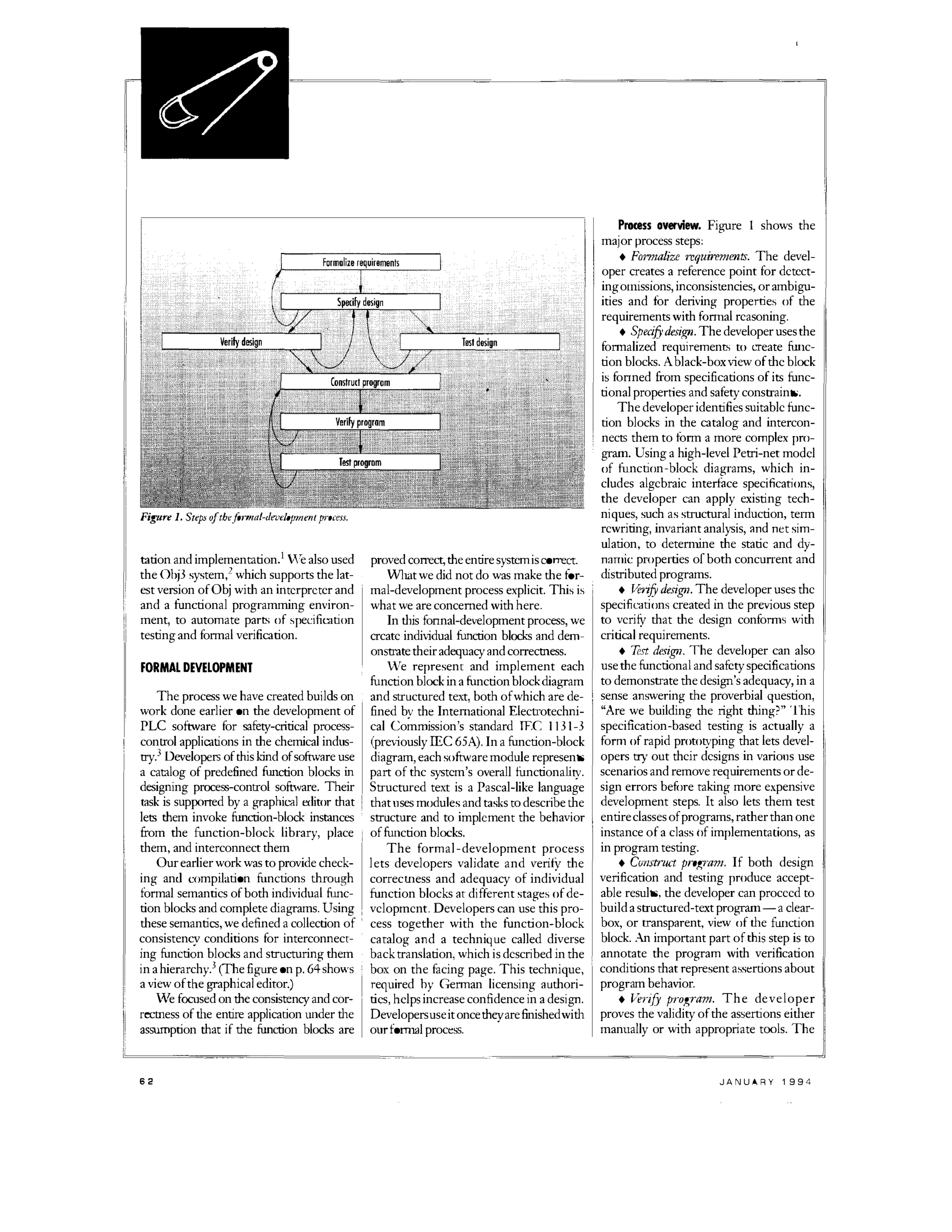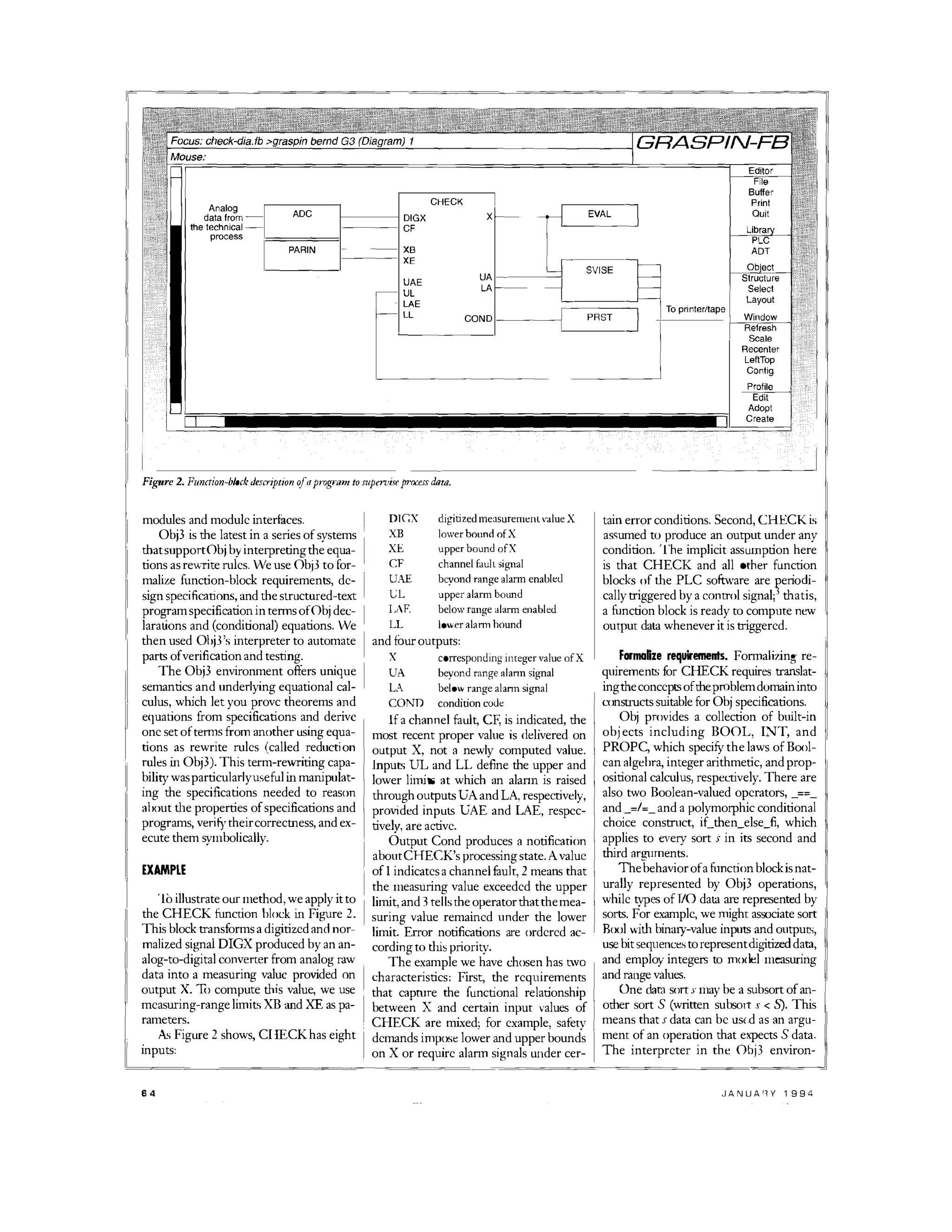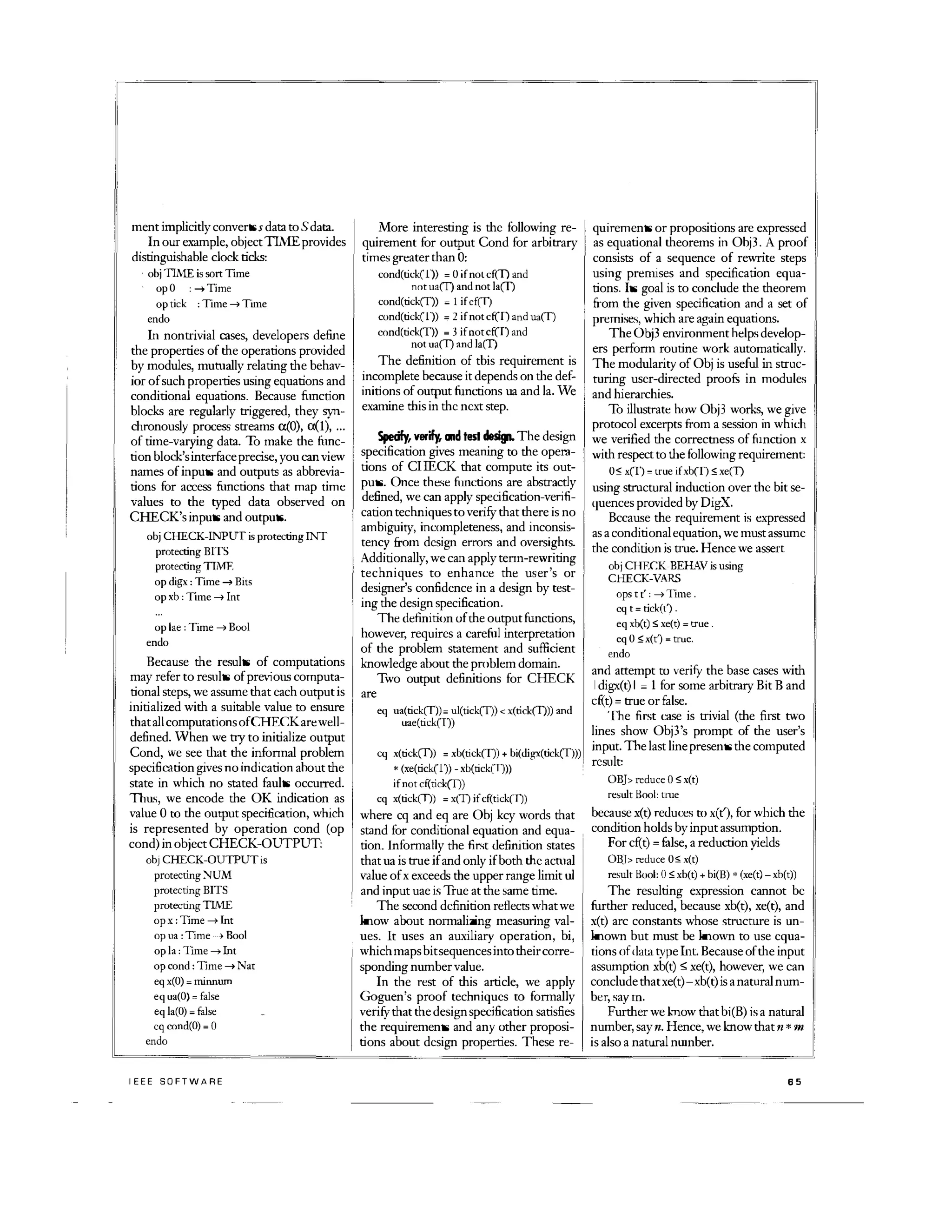The document describes a formal process for developing programmable logic controller (PLC) software to improve safety verification. The process involves:
1) Formalizing requirements and using them to specify function block designs.
2) Verifying the designs meet requirements and testing them symbolically.
3) Constructing and verifying structured text programs that implement the designs.
4) Testing the final code.
The process is demonstrated by formally developing a CHECK function block that transforms sensor readings within set limits and triggers alarms.
![•Programmable logic
controllers are popular in
process-control
applications, but the
software can be very
complex. Usingformal
specifications to create
function blocks helps make
the safety of
PLC software easier
to verify.
IEEE SOFTWARE
Safety
Assurance in
Process
Control
WOLFGANG A. HALANG and BERND]. KRAMER
FemUniversitiit Hagen
rogrammable electronic 'ys
terns are being used more and more to
control and automate functions in safety
critical applications like traffic control,
patient monitoring, and process and pro
duction-line control.
A specific class of these systems -
programmable logic controllers - are
replacing hard-wired switching networks
in a range of applications, from binary
and sequence control to process supervi
sion and otber tasks involved in industri
al process control.
The advantage of PLCs over purely
,hardware solutions is tbat they can pro
cess more information faster. Vhen tbe
process changes, developers simply re
program a PLC to adapt. Hardware, on
tbe other hand, is based on relay or dis
crete electronic logic, and so must be
rewired to a ccommodate process
changes.However, PLC software can be
very complex, and there are few sound
074G7459/94/0100jOO61 /$0300 © IEEE
and accepted methods for thoroughly
understanding, specifying, designing,
implementing, maintaining, and assess
ing a PLC's critical properties. Errors
cannot be detected solely by peer reviews
or other informal metbods typical of tra
ditional software development. Also, ex
haustive testing is impossible because
PLC software often uses concurrency or
has a huge number of program states.
Consequently, licensing autborities
are still extremely reluctant to certify
safety-critical systems whose behavior is
exclusively program-controlled.
To make it easier to verify tbe safety of
this type of software, we have created a rig
orous process tbat uses formal specifica
tions of function blocks, which are typical
ly used in safety-critical control and
automation applications. Key to tbe pro
cess is tbe use ofObj,an algebraic language
, tbat lets you specify requirements and de
I signs independently of any data represen-
61](https://image.slidesharecdn.com/00251211-150716135343-lva1-app6891/75/safety-assurence-in-process-control-1-2048.jpg)

![developer can derive verification condi
tions automatically from either the design
specification or program by usingverifica
tion-condition generators. These genera
tors rely on logical deduction systems that
use axioms and deduction rules based on
Hoare logic4 to map one set of fonnulas
into another.
We used proof techniques developed
byJoseph Goguen5 and the Obj3 system2
to verity the consistency between critical
requirements and the corresponding de
sign specification. We used a variant of
Hoare-style proof rules6 to verity that a
stmctured-text program confonns to its
specification.
Hoare logic proved to be highly suit
able for PLCs bccause these systems rely
on simple programming constructs (like
variables and constants), elementary data
types (like Boolean, integer, real, bit se
quence, character, and string), conditional
and assignment statements, statemcnt se
quences, and Boolean and arithmetic ex
pressions- all of which are easilyhandled
by Hoare logic. N"asty constructs like un
bounded loops, recursion, or subpro
grams, which complicate proofs in Hoare
logic, are avoided because they often com
promise crucial real-time requirements
like predictability and timeliness.
• Test code. The process concludes
whcn the developer tests the code that re
sults from compiling the structured-text
pmgram.The developer can use the design
specification to generate suitable test data.
This approach follows Rogerio de
Lemos and colleagues' concept of split
ting requirements into mission
(functionality) and safety categories.7
Such a split gives developcrs freedom to
choose different formalisms to express
each part, but there must be a way to ver
ity the consistency of both.
To enable a seamless integration ofdif
ferent process steps, we uniformly use an
algebraic specification technique for
stating functional properties and (first
order)safetyconstraints as well as design
and program spccifications. We also use
term rewrit'ng both in design and pro
gram verifi'_'3tion and in specification
based testint,.
Obvious]y, PLC software developers
IEEE SOFTWARE
will have to work harder to follow this
method, as opposed to conventional ap
proaches that rely on informal or semifor
mal requirements and designs pro
grammcd directly in terms of ladder
diagrams (abstractions
Obj and Obj3. We used Obj through the
entire development process to fom1alize
requirements (step I), caphlre design re
quirements (step 2), verity the correctness
of design specifications and execute them
symholically (step 3), and
and formalizations ofelec
trical current-flow dia
grams) or insnuction lists
(mainly assembly-level
vendor and machine-spe
cific procedural lan
guages).
But they will find it
well worth the effurt. First,
thousands of control pro
grams use standard fimc
tion blocks. Fonnal inter-
WITH THIS
METHOD, YOU
CAN REUSE
FUNOION
BLOCKS AS
WELL AS
to state the implemen
tation,s pre- and post- I
conditionsin Hoare logic
(step 4).
Obj is rigorously
based on order-sorted
logic; its code consists of
equations and condi
tional equations. Obj's
basic building blocks are
objects, declarations, and
theories. Objects, which
THEIR PROOFS.
face specifications make it
possible to systematically reuse fimction
blocks and the proofs to verity them.
Also, formal development providcs
more evidence about the logical consis
tency between the �Jlecification and pro
gram for all possible input data.
Finally, because developers gain
deeper insight into the problem early on,
the cost to detect errors in later develop
ment stages and maintenance is lower.
DIVERSE BACK TRANSLATION
represent initial order
sorted algebl'3s - sorted sets with an in
clusion relationshipand a family of opera
tions - are named entities that encapsu
late specific kinds of data. This data can be
manipulated only through the operations
an object provides. Declarations intro
duce the kinds ofobjects and their opera
tions. Theories support parameterized
programming by specitying both the syn
tactic snucture and semantic properties of
This technique, which is required by German licensing authorities, was developed
for the Halden experimenllli nuclear-power-plant project byTOV Rheinland.t
Developers read machine programs from memory and give them to teams. Without
contactingeach other, the teams manuallydisassemble and decompile the code with the
finalgoal of regaining the specification.Asafety license is granted to thesoftware ifits
original specification agrees with the reengineered specifications.
The methotl is generally extremely cumbersome, time consuming, and expensive.
Thereis a tremendous semantic gap between a specification formulated in terms of user
fimctions and the usual machineinstructions to carrythem out. Usingthe process de-
I
scribed in the main text helps, however, because the design is dircc'tiy mapped onto se
, quences ofprocedure invocations and the corresponding object code consists only of
thesecalls and parameter passing. Consequently, thereis little effurt tointerpret the
code, reconstruct graphical design specifications, and verifytheirconsistencywith for
malized requirements specifications.
We are pursuing new research aimed at providing automated support for diverse
back translation usingthe semantics defined in the main text.
REFERENCES
I. H. Krebs and U. Haspel, "EinVerfahren zur Software-Verifikation: Regelungstechn"che PrllXis, Feb. 1984,
pp. 73-78 (inGerman).
63](https://image.slidesharecdn.com/00251211-150716135343-lva1-app6891/75/safety-assurence-in-process-control-3-2048.jpg)


![Q = (COND = 0 and not ua and not la and not d) or
(COND == 1 and d) or
(COND == 2 and not cfand ua) or
(COND == 3 and not cf and not ua and la)
[AI
{true}
Ifnot (cfor ua or la)
Then COND := 0
Else
{efor ua or la}
lfef
Then COND ;= 1
Else
{(cf or ua or la) and not d)
Ifua
Then COND := 2
Else
(cfor ua or la) and notcfand not ua}
Ifla
Fi
Then COND := 3
Fi
{Q}
{Q}
Fi
(Q)
Fi
(Q)
[81
(not Cdor ua or la» implies Q{COND/O}
«cfor ua or la) and cf) implies Q{CONDIII
, «cfor ua or la) and not cf and ua)implies Q{CONDI2}
«efor ua or la) and not cfand not ua and la) implies Q{COND/3}
leI
OB] reduce «efor ua or la) and d) implies Q{COND/1}.
reduce in PROG-VERIFICATION:
(efor ua or la) andcfimplies Q(COND/1}
rewrites: 206
result BooI: true
101
Figure J. Part oja structured-text program to implement tbe design specification ofCHECK (A) The
function Crmd, (B) local erificatioll cOl1ditiom d7ved1m, the precondition I'me and yme postconditirfll
cOl1'esponding to tbe requh'emmtf01' output Cond, (C) the (onditirms to he verifiedfin' (B), and (D) the proof
ofthe secondcondition of(C).
Hecause 0 ; Tv1 + N holds for two arbi
trary natural numbers Tv1 and N, the base
case is verified and we can assert
xb(t) + 1 * (xe(t) - xb(t» = xe(t)
After asserting the induction assump-
tion, the indul-110Il step yields
OB] reduoe x(t)
result Bool: true
for cfCt) = false
Other properties and output func.tions
are treated similarly.
Because Obj specifications are execut
able, the design specification can also he
taken as a prototype of the CHECKfunc
tion blocktovalidate itsfunctioningUllder
6 6
the conditions of a specific application.
Simple tests of the function hi are
OBJ reduce bill 0 1)
result Nat: 5
Ul:IJ reduce birO)
result Nat: 0
ConstJud, verify, and test program. Pro
gram construction involves building a
structured-text program from the design
and adding assertions about program in
puts and outputs in the form of pre- and
postconditions. Programconstruction is a
creative step, yet it is often relatively sys
tematic. Equational statements of the de-
sign specification are transfonned into a
sequence of program statements such as
if-then-e1se clauses, assignment state
ments, and Boolean and atithmetic ex
pressions. Figure 3 shuws a section df a
structured-text program intendcd to im
plement the design specification of
CHECK. Figure 3a shows function
Condo Figure 3b shows the local verifica
tion comlitions derived from the precon
dition true and some posteonditions cor
responding to the requirementfor output.
The specification for output Cond (sec
ond column of p. 65) has been translated
into the nested if-then-else clause in Fig
ure 3b.
The goal of program verification is to !
verify a program's conformance to its
specification in a finite number of steps by
applying appropriateHoare proof rules to
the statements of that program. Hoare's
technique lets us verify the partial correct
ness of a program S with respect to asser
tions P and Q that may or may not be �
satisfied hy the variables OCCUlTing in S. An
annotated expression of the form {PIS[Q)
inf0l11lally means that, if assertion P holds
before the execution of 51, assertion Q
holds when the execution of 5 tenninates.
For example, for a conditional statement
s= IfCThen 51 Else 52 Fi
'With precondition P and postcondition R,
we can detive pre- and postconditions for
51 and S'2 using the general rule for condi
tional statements4;
{P and C] Sj (R)
{P md not C] S2 {R}
If we can find proofS for these assertions,
we also have a proof for {P}S{R}.
In the stepwise proof we proceed as
follows:
I. Start /i'om the postcondition and
tollow the program path in reverse.
2. For each statement S on this path,
apply an appropriate proof rule to trans
form the postcondition of this statement
into the weakest precondition. This pre
condition becomes the postcondition of
the preceding statement. That is, you de
rive pre- and posteonditions for the I
CHECK statements using appropriate
proof rules to end up with a structmed
text program whose individual statements
are annotated with verification conditions.
JANUARY 1094](https://image.slidesharecdn.com/00251211-150716135343-lva1-app6891/75/safety-assurence-in-process-control-6-2048.jpg)
![Figure 3c gives dle conditions to be
verified for me programin Figure 3b. The
expression Q{COND/l} denotes the
same as condition Q except that variable
Cond in Q is substiruted wim 1. Figurc 3d
shows me proof of me conditions, which
comes down to a term reduction in Obj3.
(VVe used an Obj specification not given
here do dUs reduction.)
Thus, having proved all verification
conditions generated for CHECK, we
have proved me correctness of me entire
program wim respect to its requirements
and design specifications.
To validate (test) me resulting pro
gram, we used standard techniques such as
dynamic code testing and static program
analysis. The selection of test procedure
(mutation, back-to-back, random, bound
ary checking, and so on) depends on me
domain requiremcnts and function-block
characteristics.
�ere are many advantages tousingfor
• mal specification and validation tech
niques in me development ofPLC software
for safety-related applications. The main
one is that bomPLC developers and certifi
cation authorities can use these techniques
to show a program's dependability.
Our emphasis was on demonstrating
dle functional correctness of reusable
function blocks to become members of a
domain-specific catalog of standard build
ing blocks and, merefore, justifY me extra
effort necessary to guarantee safety. Ve
hope it became clear mat manual proofu of
verification conditions, even for relatively
simple programs, are tedious and error
prone. The notations and techniques we
used - Obj, term rewriting, and Hoare
logic - are wcll-understood, supported
by effective tools, and have been success
fully used in similar experiments bom for
hardware and software specification and
verification.
By interconnecting verified function
blocks, correctness proofu are reduced to
verifYing me horiwntal and vertical con
sistency of me functional composition plus
any analyses of how individual blocks in
terplay.
Still missing is a full a=lmt of timing
properties, which occur often in me type
IEEE SOFTWARE
of process-control applications considered
here. Tinling characteristics are covered
reasonably well for individual function
blocks, but we arc still looking at how to
handle me rinling characteristics of me en
tire program. Specifically, we are experi
menting wim various logic and formal
isms, including time notions like duration
calculus, real-time logic, timed communi
cating sequential processes, and timed
Petri nets.
As an alternative to considering tinled
logic and to gain experience wim a predi
cate-logic approach, we specified a simple
timer to be used in an emergencyshut-down
system and verified its correctness using a
verifier written inhigher orderlogic.
R
The timer is a monostable element,
which cannot be retriggered and has a
selectable delay. 'hen me timer is in
me nonexcited state and detects a rising
edge at its input, it switches its output to
the logical true state for a specified
delay.
The timer relies on time readings of a
radio receiver, which provides monotoni
cally increasing time values broadcast by
official agencies mrough me satellites of
me GlobalPositioning System or wough
terrestrial stations in vari()U� cOlmtries.
Furilier experiments are underway to gain
better data for eompating me practicality
and ease of use in bom me Obj3 and HOL
approaches. •
�l����C�rinCiPles ofOB]2,·· m Pro... AC1 Symp. PrindplerofPmgmmming Languager,=-lPress� New York, 19t15, pp. 52-66.
I
2. J. Goguen and T. Winkler, Introducing OB]3, Tech. Report SRI-l:SL-RR-9, SRI Int't, Menlo Park,
��
II
3. V Halang and Il. Kramer, Achieving High Integrity of Process Control Software by Graphical Design
and Fonnal Verification. Software Engineering].,].n. 1912, pp. 53-64.
4. C. Hoare, An Axiomatic Basis for Computer Prof,'Tarnming, Cvmm. AC/'vl, Oct. 1969, pp. Si6-580.
5. J Goguen, OB) as a T heorem Prover with Applications to Hardware Verification,' Tech. Report SRI
CSL-88-4R2, SRI Int'I, Menlo Park, l:alif., 1988.
6. R. Rackhollse, Prognlfn COIJXlrIUflO'llilltd H:rifoation, Prentice-Hall, Englewood Cliffs, NJ., 1986.
7. R. dt: Lemos, A Saeed, and T. Anderson, A Train Set as a Case Study for the Requirements Analysis of
Safety-Critical Systems. The Cmnputrr].,Jan.l9l2, pp. 30-4D.
8. 11. Gordon, NlechaniLing Programming Logics in Higher Order Logic, in Current Trends in Hardware
I/e-nfication andAuwmatedTheorem Proving, G. Birmistlc and P.A Suhrahmanyam, eds., Springer-Verlag,
Berlin, 1989, pp. 387-439.
-olfgang A. Halangholds the chair of infonnation technology at FernUniversicit
J ragen, where his research interests an: predictable �ystem behavior and rigorous soft
ware verification and safety licensing. He is founder and editor-in-chief of Real-Time .�'V.I'
tcmsand has ,'littcn mare than 100 publications on real-time systems. He is coauthor
with Alexander SlOyenku ufConTructing Predhtable Reol-time Systems(Kluwer Acadmic
Publishers. 1911) and with Bernd Kramer and others ofA Safety T.imlJahle Comp1ltingAr
chitecture.
Halang received a PhD in mathematics from Ruhr-Universitat Bochum and a PhD
in computer science from the Universitat Dorbnund.
BerndKramerholdsthe chair afdata-processing technology at FernUniversitat
Hagen and is director ofthe associated InsLitute fur New'Iec:hnologies in Electrical En
ginet:ring. His research interests include fanna] specification, design and analysis tech
niques for distributed systems, advanced communicationtechniques, and development
methods for high-integritysofrniare. He is author ofC'uncepts, Syntax, ilnd Sema1ltit'Soj
SEGR4S(R. OIJenbourg, 1989) and coauthor with Wolfgang Halang and others of A
SafetyLiansable Camputing .4hitfcturr (World Scientific, 1YY3).
Kramer received a diploma and a PhD in computer science, both from the Tech
nische Universitiit Berlin.
Address questions about this drtide to Kramer at FernUniversitit Hagen, Fachbereich Elel'tratechnik, 58084
Hagen, Gennany; bernd.kraemer®fernuni-hagen.de.
67](https://image.slidesharecdn.com/00251211-150716135343-lva1-app6891/75/safety-assurence-in-process-control-7-2048.jpg)